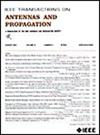3-D-Printed Ka-Band Circularly Polarized Monopulse Antenna Array With High Gain and Low Axial Ratio
IF 5.8
1区 计算机科学
Q1 ENGINEERING, ELECTRICAL & ELECTRONIC
引用次数: 0
Abstract
In this article, a 3-D-printed具有高增益和低轴向比的 3D 印刷 Ka 波段圆极化单脉冲天线阵列
本文研究了 Ka 波段的 3-D 打印 $16/times 16$ 圆极化(CP)单脉冲天线阵列,该阵列具有高增益和低轴向比(AR)的特点。单脉冲天线阵列由四个低调的左手 CP 子阵列和一个顺序旋转比较器网络(SRCN)组成。四个子阵列正交连接到 SRCN 输出端,实现了传统二维单脉冲天线阵列与顺序旋转网络之间的同步相位关系集成。为了验证设计理念,利用选择性激光熔化(SLM)3-D 打印技术单片制作了一个 $16/times 16$ 单脉冲天线阵列原型。测量结果表明,所提出的单脉冲天线阵列实现了和差输入端口 27.5 至 30.0 GHz 的共享带宽(回波损耗大于 10 dB)。左手 CP 增益高达 32.3 dBic,带内 AR 低于 0.3 dB。空深度约为 -24 dB,总效率超过 70%。所提出的单脉冲天线阵列具有增益高、CP 纯度高、效率高和功率容量大等优点,特别适用于卫星通信系统。
本文章由计算机程序翻译,如有差异,请以英文原文为准。
求助全文
约1分钟内获得全文
求助全文
来源期刊
CiteScore
10.40
自引率
28.10%
发文量
968
审稿时长
4.7 months
期刊介绍:
IEEE Transactions on Antennas and Propagation includes theoretical and experimental advances in antennas, including design and development, and in the propagation of electromagnetic waves, including scattering, diffraction, and interaction with continuous media; and applications pertaining to antennas and propagation, such as remote sensing, applied optics, and millimeter and submillimeter wave techniques

 求助内容:
求助内容: 应助结果提醒方式:
应助结果提醒方式:


